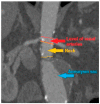The Ratio of the Size of the Abdominal Aortic Aneurysm to That of the Unchanged Aorta as a Risk Factor for Its Rupture
- PMID: 36009543
- PMCID: PMC9405575
- DOI: 10.3390/biomedicines10081997
The Ratio of the Size of the Abdominal Aortic Aneurysm to That of the Unchanged Aorta as a Risk Factor for Its Rupture
Abstract
Background: A ruptured abdominal aortic aneurysm is a severe condition associated with high mortality. Currently, the most important criterion used to estimate the risk of its rupture is the size of the aneurysm, but due to patients' anatomical variability, many aneurysms have a high risk of rupture with a small aneurysm size. We asked ourselves whether individual differences in anatomy could be taken into account when assessing the risk of rupture.
Methods: Based on the CT scan image, aneurysm and normal aorta diameters were collected from 186 individuals and compared in patients with ruptured and unruptured aneurysms. To take into account anatomical differences between patients, diameter ratios were calculated by dividing the aneurysm diameter by the diameter of the normal aorta at various heights, and then further comparisons were made.
Results: It was found that the calculated ratios differ between patients with ruptured and unruptured aneurysms. This observation is also present in patients with small aneurysms, with its maximal size below the level that indicates the need for surgical treatment. For small aneurysms, the ratios help us to estimate the risk of rupture better than the maximum sac size (AUC: 0.783 vs. 0.650).
Conclusions: The calculated ratios appear to be a valuable feature to indicate which of the small aneurysms have a high risk of rupture. The obtained results suggest the need for further confirmation of their usefulness in subsequent groups of patients.
Keywords: aneurysm rupture risk assessment; aneurysm rupture risk factors; ruptured abdominal aortic aneurysm.
Conflict of interest statement
The authors declare no conflict of interest.
Figures










Similar articles
-
Endovascular repair of abdominal aortic aneurysm: an evidence-based analysis.Ont Health Technol Assess Ser. 2002;2(1):1-46. Epub 2002 Mar 1. Ont Health Technol Assess Ser. 2002. PMID: 23074438 Free PMC article.
-
Size ratio correlates with intracranial aneurysm rupture status: a prospective study.Stroke. 2010 May;41(5):916-20. doi: 10.1161/STROKEAHA.109.574244. Epub 2010 Apr 8. Stroke. 2010. PMID: 20378866
-
Coil embolization for intracranial aneurysms: an evidence-based analysis.Ont Health Technol Assess Ser. 2006;6(1):1-114. Epub 2006 Jan 1. Ont Health Technol Assess Ser. 2006. PMID: 23074479 Free PMC article.
-
Endovascular stent grafting and open surgical replacement for chronic thoracic aortic aneurysms: a systematic review and prospective cohort study.Health Technol Assess. 2022 Jan;26(6):1-166. doi: 10.3310/ABUT7744. Health Technol Assess. 2022. PMID: 35094747
-
Sealed rupture of abdominal aortic aneurysms: CT features in 6 patients and a review of the literature.Abdom Imaging. 2010 Feb;35(1):99-105. doi: 10.1007/s00261-008-9488-1. Epub 2008 Dec 10. Abdom Imaging. 2010. PMID: 19082650 Review.
Cited by
-
Aortic Aneurysm: Finding the Right Target.Biomedicines. 2023 May 3;11(5):1345. doi: 10.3390/biomedicines11051345. Biomedicines. 2023. PMID: 37239016 Free PMC article.
-
Computed Tomography Angiography Markers and Intraluminal Thrombus Morphology as Predictors of Abdominal Aortic Aneurysm Rupture.Int J Environ Res Public Health. 2022 Nov 30;19(23):15961. doi: 10.3390/ijerph192315961. Int J Environ Res Public Health. 2022. PMID: 36498041 Free PMC article.
-
Interventional treatment of peripancreatic aneurysms: can one strategy fit all?CVIR Endovasc. 2025 Mar 19;8(1):23. doi: 10.1186/s42155-025-00533-2. CVIR Endovasc. 2025. PMID: 40106113 Free PMC article.
References
-
- Raux M., Marzelle J., Kobeiter H., Dhonneur G., Allaire E., Cochennec F., Becquemin J.-P., Desgranges P. Endovascular balloon occlusion is associated with reduced intraoperative mortality of unstable patients with ruptured abdominal aortic aneurysm but fails to improve other outcomes. J. Vasc. Surg. 2015;61:304–308. doi: 10.1016/j.jvs.2014.07.098. - DOI - PubMed
LinkOut - more resources
Full Text Sources

